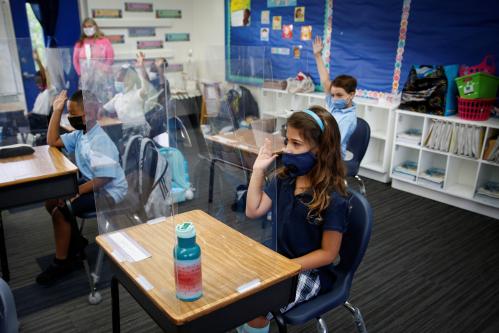This article is part of the “COVID-19 and education: Five years later” series in which Brown Center experts and external contributors reflect on the five-year anniversary of the COVID-19 pandemic and its ongoing impact on education policy, politics, and practice.
In March 2020, U.S. schools closed to slow the spread of the COVID-19 virus, triggering the largest interruption to the U.S. education system in generations. We have consistently documented the toll of the pandemic on American students and schools. Now, five years later, a clear picture has emerged of how students have fared and the degree to which they have recovered.1 Drawing from multiple national and state-level data sources, we find small-but-promising signs of recovery in math and no widespread evidence of recovery in English language arts (ELA). While some students and districts have made progress, many educational inequalities have widened, making full recovery a distant prospect.
In this article, we provide an updated look at the broader landscape of available evidence about COVID-19 recovery, synthesizing findings from national assessments, interim assessments, and state summative tests. We also discuss what these trends mean for policymakers and educators navigating recovery efforts despite current financial headwinds.
Slight academic recovery in math, continued declines in ELA
We start by comparing recovery trends between 2022 and 2024 across the National Assessment of Educational Progress (NAEP), the Education Recovery Scorecard (ERS), and three interim assessments (NWEA MAP Growth, Curriculum Associates i-Ready, and Renaissance STAR).2 By pooling results across multiple tests—each given to different samples with different purposes—we gain greater confidence that the results reflect true national trends over time.
As Figure 1 shows, a consistent story emerges from these different assessments. In ELA, data from four of the five assessments shows continued declines between 2022 and 2024. Only the Renaissance data shows sizable improvements.
In math, all data sources indicate modest recovery between 2022 and 2024, though the assessments differ both in the size of the improvement as well as the magnitude of the initial drop (between 2019 and 2022, shown as the first data point in the figure). At the current rate of progress, most data sources indicate full recovery in math is over seven years away.3
To put these test score declines in perspective, we can compare them to what we know about educational improvement. Even the most effective, well-implemented interventions rarely boost student achievement by more than 0.05 to 0.15 standard deviations. Yet, five years after COVID-19, the average learning losses (0.12 standard deviations in ELA and 0.17 in math) near or exceed that upper threshold. This is why recovery has been so challenging. The pandemic created gaps that, under ideal circumstances, would take multiple years of intensive, high-impact interventions to close.
FIGURE 1
Slight increases in math scores but no progress in ELA from 2022 to 2024
Source: Standardized estimates are calculated based on raw data from the following sources. Curriculum Associates: Scale scores from Appendix Table 5 in Curriculum Associates (2024); Spring SDs from Briggs & Wellspring (2022); Education Recovery Scorecard (ERS): Grade-level estimates reported in Dewey et al (2025), standardized estimates from personal communication; NAEP: Scale scores and SDs from data tables available at NAEP report card website; NWEA: Scale scores and spring 2019 SDs from Table 10 in Kuhfeld & Lewis (2024); Renaissance: Scale scores from “How Kids Are Performing”; Spring SDs from Renaissance technical manual (2022).
Note: Online Table 1 provides the source estimates for each data source. We applied a consistent standardization approach to each data source (subtracting off the 2019 mean and dividing by the spring 2019 SD). We then pooled data across grades 3-8 (or whichever grades were available) to give a single standardized estimate per subject and data source. ELA=English Language Arts.
Why is math recovering (albeit slowly and modestly) but reading is continuing to decline? It’s hard to say. One possibility is that schools focused recovery efforts more heavily on math skills coming out of the pandemic, since math is where the largest initial drops were reported. Another factor may be that math, by its nature, is easier to remediate. Mathematical concepts can often be broken down into discrete skills, making targeted interventions easier to implement. In contrast, progress in ELA may be more dependent on broader instructional shifts, such as the adoption of research-aligned reading practices. These practices vary widely across states and districts—and take time to translate into measurable gains in student outcomes.
Next, we look to state assessments to see what story they tell. State tests provide key data points for policymakers and education leaders tracking recovery, but they have some limitations for an analysis like ours. For example, because each state sets its own cut scores and test design, proficiency rates can’t be directly compared across states. Also, states often report scores in terms of percent proficient, which provides a limited view of student performance. Instead of examining the magnitude of score drops, we take a more qualitative approach, looking at overall trends to examine whether proficiency rates returned to pre-pandemic levels.4
We categorized each state into one of four groups based on changes in proficiency rates:
- Recovered or Exceeding – Spring 2024 proficiency rates are at or above spring 2019 levels.
- Making Progress – Proficiency rates in spring 2024 have increased by at least 2 percentage points since spring 2022 but remain below spring 2019 levels.
- Minimal Change – Proficiency rates in spring 2024 are within ±2 percentage points of spring 2022 and still below spring 2019 levels.
- Continued Decline – Proficiency rates in spring 2024 have dropped by at least 2 percentage points since spring 2022 and remain below spring 2019 levels.
Figure 2 summarizes the trends across all states with available data. This graph tells a consistent story with what we have learned from interim and national assessments: Math is showing more recovery than ELA, but full recovery remains elusive.
In math, three-quarters of states with available data fall into the Making Progress category, indicating proficiency rates have improved since 2022 but remain below 2019 levels. Only 8% of states have fully Recovered, while 11% saw Minimal Change and a small share (3%) saw Continued Decline.
In ELA, recovery has been far more uneven. More than one-third of states showed Minimal Change and another 19% experienced Continued Decline. It is also worth noting that while 6 states (16% of the states with available data) are considered Recovered in ELA based on summative assessments, only a single state has significantly higher ELA scores in 2024 than 2019 on the NAEP 4th-grade reading assessments.5
The pace of recovery has differed across communities and student subgroups
The overall story of test score trends, while important, masks critical differences across student groups. Understanding these disparities is essential for ensuring that resources are allocated where they are needed most.
Recovery patterns have been highly uneven, with historically underserved students and the lowest-performing students recovering at slower rates. Districts that stayed remote/hybrid longer—many of which serve higher shares of low-income students and students of color—experienced the greatest losses during the pandemic and still have the most ground to make up. While Black students have shown promising gains, Hispanic and economically disadvantaged students are recovering more slowly than peers. Additionally, girls have shown more sizable test score drops than boys during COVID-19. In 8th grade math, a gender gap favoring boys reemerged for the first time in 20 years.
Another troubling trend is the widening gap between low- and high-performing students. Across multiple assessments, test scores increased for many students who were already doing well, while struggling students fell further behind their peers. The highest-performing students on the NAEP assessment actually made gains since 2022 in math, while students below the 25th percentile showed continued declines.
Recovery patterns also vary by state policies and district funding decisions. For instance, Louisiana’s adoption of research-backed reading practices may have contributed to it being a rare bright spot in the latest NAEP results. Federal pandemic aid helped mitigate learning loss, but with ESSER funds now expired, scaling effective interventions—like high-dosage tutoring and extended learning time—remains a major challenge.
Looking to the future
The current moment represents a perilous time for recovery. Millions of dollars of ESSER funds ran out in fall 2024, meaning that dollars that supported recovery programs are no longer available in most districts. Additionally, school district enrollment has been declining over the last decade, resulting in further drops in school funding and hard decisions around school closures. Furthermore, cuts of almost a billion dollars in funding for educational research, technical assistance, and important federal data collection efforts could imperil further recovery.
Given that U.S. students still have a very long road to full recovery, where do we go from here? Tackling the ongoing problem of chronic absenteeism, which has been linked to slower recovery rates, is one place to start. Focusing on improving the quality and implementation of core curriculum, particularly in reading, should also be a main priority. In the absence of federal funds to support recovery programs, states should consider investing in evidence-supported interventions such as tutoring and summer learning programs. Finally, school leaders and policymakers should continue to advocate for high-quality data (such as NAEP) that allow for understanding both areas of success and where additional supports are needed.
The challenges facing today’s students are not of their own making. It’s our responsibility to make things right. The pandemic exacerbated longstanding inequities, deepening the educational debt we owe this generation. Meeting this moment demands more than temporary fixes. It requires sustained attention, targeted investment, and evidence-based innovation. The stakes are too high to risk falling short.
Yet alongside these challenges, we have unprecedented tools at our disposal to support recovery. Emerging technologies, including AI, are generating excitement about their potential to transform education. While these innovations could help close gaps and expand opportunities, their impact will depend on how they are integrated into classrooms and learning systems. It will require deep commitment to evidence-based decision-making to ensure such advancements reduce, rather than deepen, existing disparities. The data tells us where we stand; our response will determine where our students go.
-
Footnotes
- In this study, we are defining “fully recovered” as test scores that are equal to or exceeding pre-pandemic (spring 2019) achievement levels. However, we acknowledge the pandemic impacted many domains (e.g., mental health, behavior, school safety, and teacher well-being) that are not captured in this definition but also worthy of consideration and study.
- For more details about the methodology used to estimate recovery trends across datasets, see https://www.brookings.edu/articles/assessing-evidence-of-academic-recovery-slight-progress-in-math-hardly-any-in-ela/. The online table linked in Figure 1 provides the individual estimates for each dataset.
- Years to recovery is calculated by dividing the gap in 2024 by the average yearly rate of improvement between 2022 and 2024. The Renaissance data provides a more optimistic estimate of three years to full recovery.
- Percent proficiency data were obtained from Zelma. We requested the average percent proficient in each year, subject, and state (pooling across grades 3 through 8). States with known changes in proficiency thresholds or test design during this period have been removed from the analysis. However, not all test modifications are publicly documented, meaning some undetected changes could affect trend comparisons.
- State test designs and proficiency cut score changes may contribute to these inconsistencies.
The Brookings Institution is committed to quality, independence, and impact.
We are supported by a diverse array of funders. In line with our values and policies, each Brookings publication represents the sole views of its author(s).










